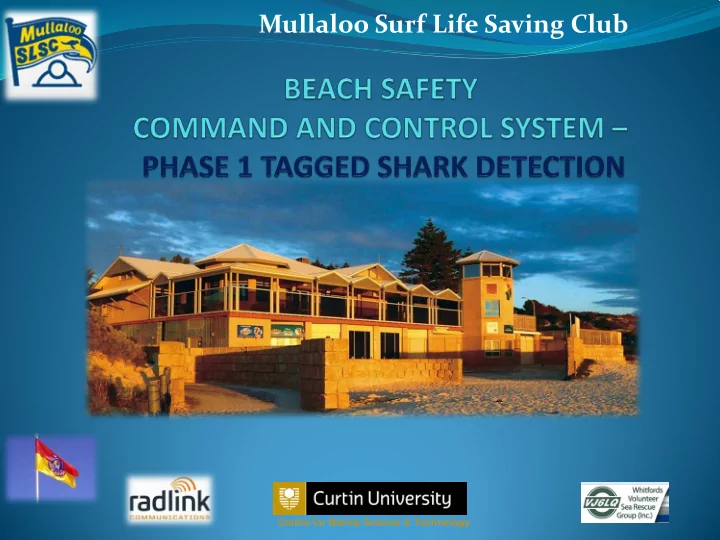

Mullaloo Surf Life Saving Club Centre for Marine Science & Technology
Why - The attack - June 12 th 2012
Finding Ways to Make Our Beaches Safer Objective – Develop effective Detection & Protection methods Detection Improvements Tag detection (Phase 1 – completed with BeachLAB) Above water detection (Requires funding) EG CCTV, Drones New technologies – SONAR (Work in progress with CMST) Protection Alerting methods (Lights, sirens, smart phones) Coordination and incident management Centre for Marine Science & Technology
Core System Requirements Multiple Inputs Integration Sensors Central control system Cameras Social media channels Manual activation channels Web sites Alerts Flexibility Reliability Beach zones Sensor heart-beat testing Sirens Radio link integrity testing Lights Dual hardware platforms UPS power support Centre for Marine Science & Technology
A partnership between Curtin University - Centre for Marine Science and Technology (CMST) and Mullaloo Surf Club Centre for Marine Science & Technology
Beach Lab – Joint initiative Curtin University (CMST) & Mullaloo Surf Club Applied science Acoustic studies Evidence based Bio-diversity studies Requires commercial funding Scientific validation Testing at Mullaloo beach PhD studies Verify distances Reliability Between detectors Sensor heart-beat testing Optimal arrays Acoustic science Centre for Marine Science & Technology
Beach Lab aims to provide in water detection and protection of swimmers using current technology Centre for Marine Science & Technology
Coverage with below-water detection
Future state 1. Acoustic 2. Sonar 3. Rip detection 1. Acoustic 2. Sonar 3. Rip detection Centre for Marine Science & Technology
System Topology – Initial phase ready Manual activation Tag detection (Now proven) Data Acquisition Business rules Command and Sensor data Control system Alerts management Beach zone alert units
System Topology (Future state) Sonar detection Rip detection Manual activation Tag detection Data Acquisition Business rules Command and Sensor Control system data Target acquisition Alerts management Beach zone alert units Variable messaging Centre for Marine Science & Technology
Applied science to current problems Western Australia is home to some magnificent beaches, spread along the state’s 12,000 kilometres of pristine coastline. There are hundreds or beaches throughout Western Australia but not all of them are patrolled by lifeguards. Centre for Marine Science & Technology
Benefits to the community Applied science for in-water detection Applies to patrolled or unpatrolled beaches (Remote) 24 x 7 Operation ability Consistent approach to alert protocols in line with SLSWA Ease of use console and Smartphone applications The Key is alert and instant response ! Centre for Marine Science & Technology
Achieved so far: Phase 1 for in water detection (Tags) Applies to patrolled or unpatrolled beaches (Remote) 24 x 7 Operation ability (Siren times set) Consistent approach to alert protocols in line with SLSA Ease of use console and Smartphone applications The Key is alert and instant response ! Currently only detects tagged sharks. (Approx > 200 in WA) Centre for Marine Science & Technology
Next steps: August 2015 Phase 2 for in water detection (Sonar) - Detects ALL marine life. Applies to patrolled or unpatrolled beaches (Remote) 24 x 7 Operation ability Consistent approach to alert protocols in line with SLSWA Ease of use console and Smartphone applications The Key is alert and instant response on all detections! SONAR Detects ALL sharks. (Not limited to tagged sharks) Requires funding for Curtin Uni to prove up the best units Centre for Marine Science & Technology
System array’s can cover all beach sizes North Zone Central Zone South Zone Centre for Marine Science & Technology
Future Direction Shark detection • Range testing in conjunction with Curtin University (CMST) • Placement of additional acoustic receivers to provide large coverage • Placement of associated zone towers for alert purposes • Integration to website to provide real-time and historic data on tag detections • Sonar enhancement (Future state requires funding) Rip detection • Automated beach closure • Remote monitoring and management from central control post Remote beach management • Rip detection • Shark detection • CCTV surveillance with autonomous activation
Sonar imaging approach Centre for Marine Science & Technology
Futures - Rip Current Detector Rip detection Local zone Alert for rips
Futures - Mullaloo Beach Lab Tag detection (Now) Phase 1 complete Phase 2 awaiting funds Sonar (Awaiting funding) Rip detection (Ready awaiting funding) Hydrophone Centre for Marine Science & Technology
Recommend
More recommend